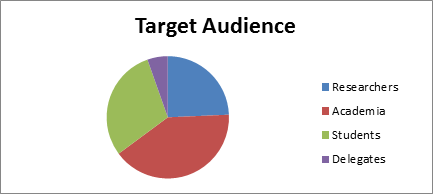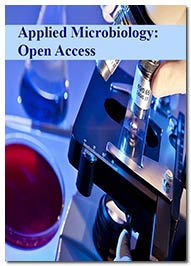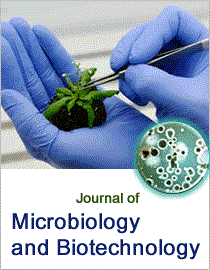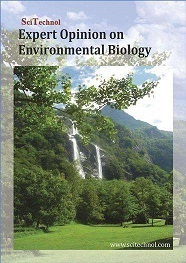Theme: Traditional & Theoretic Approach towards Environmental Microbiology
Environmental Microbiology 2017
Conference series LLC welcomes you to attend the 6th International Conference on Environmental Microbiology& Soil Microbiology September 18-20, 2017 at Toronto, Canada on the theme " Traditional & Theoretic Approach towards Environmental Microbiology ".We cordially invite all the participants interested in sharing their knowledge and research in the arena of Environmental Microbiology& Soil Microbiology.
Environmental Microbiology - 2017 provides a platform for researchers/scientists to share and globalize their research work while the participants from industry can promote their products thus felicitating dissemination of knowledge. We anticipate more than 300 participants around the globe with thought provoking keynote lectures, oral and poster presentations. The attending delegates include Editorial Board Members of related journals. The scope of Environmental Microbiology-2017 is to bring the advancements in the field of Environmental Microbiology and Soil Microbiology
Why to attend?
Environmental Microbiology Conference is the indigenous knowledge which is the result of datum and experience collection of local folks and societies in successive generations is a valuable body that should be considered for getting to sustainable development.Its success and resilience results from the profound influence that microorganisms have on life on Earth, sustaining our environment, influencing our health and driving many industrial biotechnology processes. Research areas that are marine and freshwater biogeochemical cycles and the influence of microbes on climate change through consumption and production of greenhouse gases, bioremediation of contaminated land and water, production of biofuels and use as biocatalysts, the importance of microbes in human health, interactions of microbes with animals and plants. Areas of microbiological research covered have an immense impact on the environment and mankind and thus Environmental Microbiology remains a very vibrant and highly topical research field.
Why in Toronto, Canada?
Toronto is Canada's largest city, the fourth largest in North America, and home to a diverse population of about 2.8 million people. It's a global centre for business, finance, arts and culture and is consistently ranked one of the world's most livable cities. Toronto has a vibrant history of change and growth, ranging from its early occupation over 1,000 years ago to its current status as North America’s fourth largest city. Toronto is Canada's largest municipality and is made up of the former cities of Toronto, North York, Scarborough, York and Etobicoke, and the former borough of East York. The city is home to a large immigrant population, and is a national and international hub for finance, communications and cultural life. Diverse cultures, climates and landscape make Canada a destination to suit any interest. Canada is a country of immigrants and has a policy of encouraging diversity. Thus, urban hubs feature a range of ethnic neighbourhoods, restaurants, and shops. In addition to rich and varied urban centres, Canada’s natural environment is one of the most beautiful in the world. From pristine coastlines to rugged mountains and sparkling lakes, Canada’s geography inspires awe coast to coast.
The western side of Toronto is sometimes only thought of as place where industry and residences bump up against each other, but it is also a place where there are wonderful parks and waterways and where numerous pockets of small businesses and local spirit create active and diverse communities. Combining suburban enclaves and malls with condominium developments and the dense business district surrounding the North York Civic Centre, the north-central tip of Toronto is at once both relaxed and exciting. The area is also home to York University and Black Creek Pioneer Village.
Track 1- Aero Microbiology
Aero-Microbiology is the study of living animate microbes that are quiescent in the air. These microbes are attributed to as bio-aerosols .There are significantly earth atmospheric microorganisms than in oceans and soils; there is still a large bounteous number that they can affect the atmosphere . Once attributed in the air column, these microbes have the scope to travel long distances with the help of air and precipitation, increasing the occurrence of widespread disease by these microbes. These aerosols are ecologically suggestive because they can be identify with disease in humans, animals and plants. Typically microbes will be dependent in clouds. They are able to execute processes that alter the chemical composition of the cloud, and may even induce condensation.
Related Microbiology Conferences | Microbiologists Events:
World Congress on Mycotoxins February 27-28, 2017 Amsterdam, Netherlands, 9th International Virology Congress and Expo March 13-15, 2017 London, UK, 10th World Congress on Virology and Mycology May 11-12, 2017 Singapore, International Conference On Microbial Engineering May 29-31, 2017 Beijing, China, Global Pharmaceutical Microbiology Conference June 19-20, 2017 London, UK, International Conference on Fungal Diseases & Control September 25-26, 2017 Dubai, UAE, 7th Annual Congress on Clinical MicrobiologySeptember 25-26, 2017 Chicago, USA, 2nd International Conference and Expo on Water Microbiology & Novel Technologies August 28-30, 2017 Philadelphia, USA,
Track 2 - Forest Microbiology
This Forest micorbiology is on sympathetic the activities of living organisms in the forest, like trees and mushrooms, from the organic and inorganic biochemical point of view these actions can be used to magnify human life, such as by depressed down and detoxifying environmental pollutants, and searching for physiologically active substances obtainable from trees. It plays the role of a natural protective that prevents timber from decaying easily. Although ordinary micro-organisms like bacteria and fungi cannot decompose lignin, there is one oddball micro-organism in forests that does break lignin down. This microbes is called white rot fungus because it makes timber turn white and disintegration.
Related Microbiology Conferences | Microbiologists Events:
World Congress on Mycotoxins February 27-28, 2017 Amsterdam, Netherlands, 9th International Virology Congress and Expo March 13-15, 2017 London, UK, 10th World Congress on Virology and Mycology May 11-12, 2017 Singapore, International Conference On Microbial Engineering May 29-31, 2017 Beijing, China, Global Pharmaceutical Microbiology Conference June 19-20, 2017 London, UK, International Conference on Fungal Diseases & Control September 25-26, 2017 Dubai, UAE, 7th Annual Congress on Clinical MicrobiologySeptember 25-26, 2017 Chicago, USA, 2nd International Conference and Expo on Water Microbiology & Novel Technologies August 28-30, 2017 Philadelphia, USA,
Track 3 - Microbial Biodegradation
Microbial biodegredation is the use of bioremediation and biotransformation methods to harness the naturally occurring ability of microbial xenobiotic metabolism to degrade, transform or accumulate environmental pollutants, including hydrocarbons (e.g. oil), polychlorinated biphenyls (PCBs), polyaromatic hydrocarbons (PAHs), heterocyclic compounds (such as pyridine or quinoline), pharmaceutical substances, radionuclides and metals.
Related Microbiology Conferences | Microbiologists Events:
World Congress on Mycotoxins February 27-28, 2017 Amsterdam, Netherlands, 9th International Virology Congress and Expo March 13-15, 2017 London, UK, 10th World Congress on Virology and Mycology May 11-12, 2017 Singapore, International Conference On Microbial Engineering May 29-31, 2017 Beijing, China, Global Pharmaceutical Microbiology Conference June 19-20, 2017 London, UK, International Conference on Fungal Diseases & Control September 25-26, 2017 Dubai, UAE, 7th Annual Congress on Clinical MicrobiologySeptember 25-26, 2017 Chicago, USA, 2nd International Conference and Expo on Water Microbiology & Novel Technologies August 28-30, 2017 Philadelphia, USA,
Track 4 - Microbial Biogeochemistry
Coastal upwelling regimes associated with eastern boundary currents are the most biologically productive ecosystems in the ocean. As a result, they play a disproportionately important role in the microbially mediated cycling of marine nutrients. These systems are characterized by strong natural variations in carbon dioxide concentrations, pH, nutrient levels and sea surface temperatures on both seasonal and interannual timescales. Despite this natural variability, changes resulting from human activities are starting to emerge. Carbon dioxide derived from fossil fuel combustion is adding to the acidity of upwelled low-pH waters. Low-oxygen waters associated with coastal upwelling systems are growing in their extent and intensity as a result of a rise in upper ocean temperatures and productivity.
Related Microbiology Conferences | Microbiologists Events:
World Congress on Mycotoxins February 27-28, 2017 Amsterdam, Netherlands, 9th International Virology Congress and Expo March 13-15, 2017 London, UK, 10th World Congress on Virology and Mycology May 11-12, 2017 Singapore, International Conference On Microbial Engineering May 29-31, 2017 Beijing, China, Global Pharmaceutical Microbiology Conference June 19-20, 2017 London, UK, International Conference on Fungal Diseases & Control September 25-26, 2017 Dubai, UAE, 7th Annual Congress on Clinical MicrobiologySeptember 25-26, 2017 Chicago, USA, 2nd International Conference and Expo on Water Microbiology & Novel Technologies August 28-30, 2017 Philadelphia, USA,
Track 5 - Agriculture Microbiology
Agricultural microbiology is a field of study concerned with plant-associated microbes. It aims to address problems in agricultural practices usually caused by a lack of biodiversity in microbial communities. An understanding of microbial strains relevant to agricultural applications is useful in the enhancement of factors such as soil nutrients, plant-pathogen resistance, crop robustness, fertilization uptake efficiency, and more. The many symbiotic relationships between plants and microbes can ultimately be exploited for greater food production necessary to feed the expanding human populace, in addition to safer farming techniques for the sake of minimizing ecological disruption.
Related Microbiology Conferences | Microbiologists Events:
World Congress on Mycotoxins February 27-28, 2017 Amsterdam, Netherlands, 9th International Virology Congress and Expo March 13-15, 2017 London, UK, 10th World Congress on Virology and Mycology May 11-12, 2017 Singapore, International Conference On Microbial Engineering May 29-31, 2017 Beijing, China, Global Pharmaceutical Microbiology Conference June 19-20, 2017 London, UK, International Conference on Fungal Diseases & Control September 25-26, 2017 Dubai, UAE, 7th Annual Congress on Clinical MicrobiologySeptember 25-26, 2017 Chicago, USA, 2nd International Conference and Expo on Water Microbiology & Novel Technologies August 28-30, 2017 Philadelphia, USA,
Track 6 - Industrial Microbiology
Industrial microbiology may be defined as the study of the large-scale and profit motivated production of microorganisms or their products for direct use, or as inputs in the manufacture of other goods. Thus yeasts may be produced for direct consumption as food for humans or as animal feed, or for use in bread-making; their product, ethanol,may also be consumed in the form of alcoholic beverages, or used in the manufacture of perfumes, pharmaceuticals, etc. Industrial microbiology is clearly a branch of biotechnology and includes the traditional and nucleic acid aspects.
Related Microbiology Conferences | Microbiologists Events:
World Congress on Mycotoxins February 27-28, 2017 Amsterdam, Netherlands, 9th International Virology Congress and Expo March 13-15, 2017 London, UK, 10th World Congress on Virology and Mycology May 11-12, 2017 Singapore, International Conference On Microbial Engineering May 29-31, 2017 Beijing, China, Global Pharmaceutical Microbiology Conference June 19-20, 2017 London, UK, International Conference on Fungal Diseases & Control September 25-26, 2017 Dubai, UAE, 7th Annual Congress on Clinical MicrobiologySeptember 25-26, 2017 Chicago, USA, 2nd International Conference and Expo on Water Microbiology & Novel Technologies August 28-30, 2017 Philadelphia, USA,
Track 7 - Biogeochemical cycles
Biogeochemical cycles involve the fluxes of chemical elements among different parts of the Earth: from living to non-living, from atmosphere to land to sea, and from soils to plants. They are called “cycles” because matter is always conserved and because elements move to and from major pools via a variety of two-way fluxes, although some elements are stored in locations or in forms that are differentially accessible to living things. Human activities have mobilized Earth elements and accelerated their cycles – for example, more than doubling the amount of reactive nitrogen that has been added to the biosphere since pre-industrial times., Reactive nitrogen is any nitrogen compound that is biologically, chemically, or radiatively active, like nitrous oxide and ammonia, but not nitrogen gas (N2).
Related Microbiology Conferences | Microbiologists Events:
World Congress on Mycotoxins February 27-28, 2017 Amsterdam, Netherlands, 9th International Virology Congress and Expo March 13-15, 2017 London, UK, 10th World Congress on Virology and Mycology May 11-12, 2017 Singapore, International Conference On Microbial Engineering May 29-31, 2017 Beijing, China, Global Pharmaceutical Microbiology Conference June 19-20, 2017 London, UK, International Conference on Fungal Diseases & Control September 25-26, 2017 Dubai, UAE, 7th Annual Congress on Clinical MicrobiologySeptember 25-26, 2017 Chicago, USA, 2nd International Conference and Expo on Water Microbiology & Novel Technologies August 28-30, 2017 Philadelphia, USA,
Track 8 - Subsurface Microbiology
Subsurface microbiology is a rising field in geomicrobiology, environmental microbiology and microbial ecology that focuses on the molecular detection and quantification, cultivation, biogeographic examination, and distribution of bacteria, archaea, and eukarya that permeate the subsurface biosphere. The deep biosphere includes a variety of subsurface habitats, such as terrestrial deep aquifer systems or mines, deeply buried hydrocarbon reservoirs, marine sediments and the basaltic ocean crust. The deep subsurface biosphere abounds with uncultured, only recently discovered and at best incompletely understood microbial populations. So far, microbial cells and DNA remain detectable at sediment depths of more than 1 km and life appears limited mostly by heat in the deep subsurface.
Related Microbiology Conferences | Microbiologists Events:
World Congress on Mycotoxins February 27-28, 2017 Amsterdam, Netherlands, 9th International Virology Congress and Expo March 13-15, 2017 London, UK, 10th World Congress on Virology and Mycology May 11-12, 2017 Singapore, International Conference On Microbial Engineering May 29-31, 2017 Beijing, China, Global Pharmaceutical Microbiology Conference June 19-20, 2017 London, UK, International Conference on Fungal Diseases & Control September 25-26, 2017 Dubai, UAE, 7th Annual Congress on Clinical MicrobiologySeptember 25-26, 2017 Chicago, USA, 2nd International Conference and Expo on Water Microbiology & Novel Technologies August 28-30, 2017 Philadelphia, USA,
Track 9 - Plant Pathology and Microbiology
Plant pathology or phytopathology is the scientific study of diseases in plants caused by pathogens (infectious organisms) and environmental conditions (physiological factors). Organisms that cause infectious disease include fungi, oomycetes, bacteria, viruses,viroids, virus-like organisms, phytoplasmas, protozoa, nematodes and parasitic plants. Not included are ectoparasites like insects, mites,vertebrate, or other pests that affect plant health by consumption of plant tissues. Plant pathology also involves the study of pathogen identification, disease etiology, disease cycles, economic impact, plant disease epidemiology, plant disease resistance, how plant diseases affect humans and animals, pathosystem genetics, and management of plant diseases.Microbiology methods in mycology, bacteriology, virology, nematology, applied microbiology etc.
Related Microbiology Conferences | Microbiologists Events:
World Congress on Mycotoxins February 27-28, 2017 Amsterdam, Netherlands, 9th International Virology Congress and Expo March 13-15, 2017 London, UK, 10th World Congress on Virology and Mycology May 11-12, 2017 Singapore, International Conference On Microbial Engineering May 29-31, 2017 Beijing, China, Global Pharmaceutical Microbiology Conference June 19-20, 2017 London, UK, International Conference on Fungal Diseases & Control September 25-26, 2017 Dubai, UAE, 7th Annual Congress on Clinical MicrobiologySeptember 25-26, 2017 Chicago, USA, 2nd International Conference and Expo on Water Microbiology & Novel Technologies August 28-30, 2017 Philadelphia, USA,
Track 10 - Microbes in Water
Water microbiology is concerned with the microorganisms that live in water, or transferred from one habitat to another by water. Another group of microbes of concern in water microbiology are protozoa. The two protozoa of the most concern are Giardia and Cryptosporidium. They live normally in the intestinal tract of animals such as beaver and deer. Giardia and Cryptosporidium form dormant and hardy forms called cysts during their life cycles. The cyst forms are resistant to chlorine, which is the most popular form of drinking water disinfection, and can pass through the filters used in many water treatment plants. If ingested in drinking water they can cause debilitating and prolonged diarrhea in humans, and can be life threatening to those people with impaired immune.
Related Microbiology Conferences | Microbiologists Events:
World Congress on Mycotoxins February 27-28, 2017 Amsterdam, Netherlands, 9th International Virology Congress and Expo March 13-15, 2017 London, UK, 10th World Congress on Virology and Mycology May 11-12, 2017 Singapore, International Conference On Microbial Engineering May 29-31, 2017 Beijing, China, Global Pharmaceutical Microbiology Conference June 19-20, 2017 London, UK, International Conference on Fungal Diseases & Control September 25-26, 2017 Dubai, UAE, 7th Annual Congress on Clinical MicrobiologySeptember 25-26, 2017 Chicago, USA, 2nd International Conference and Expo on Water Microbiology & Novel Technologies August 28-30, 2017 Philadelphia, USA,
Growth in environmental microbiology is moving the global market for microbiology technology, equipment, and consumables. Research reveals in its new report that new technologies are facilitating simpler methods of handling samples, while the potential for biosensors is making this field less labor- and time-consuming, which is encouraging the expansion of microbiology technology applications for environmental monitoring.
The global market for microbiology technology, equipment and consumables market, which reached $9.8 billion revenue in 2015, should total nearly $12.3 billion by 2020, reflecting a five-year compound annual growth rate (CAGR) of 4.6%. Automation and technology as a segment reached nearly $3.7 billion in 2015, and should reach more than $4.9 billion in 2020, increasing at a five-year CAGR of 6.1%. Equipment as a segment totaled $3.6 billion in 2015, and should total more than $4.1 billion in 2020, demonstrating a five-year CAGR of 2.8%.
Environmental Microbiology related equipment revenue approx. mortality per year:
New technology—and newer uses of older technologies such as PCR—is driving the growth of the clinical diagnostic segment. PCR is scaling down to be simpler to use, even to the development of point-of-care diagnostics. Automation in clinical diagnostics has led to falling costs for clinical microbiology, which in turn has reduced cost pressures—particularly cost-per-test—among health care providers.
Lower crude oil prices have limited the outlook for biofuel. However, government policy demands for renewable fuel have put a floor in the market, and many biofuel producers are pivoting towards petrochemicals traditionally produced as byproducts of the refinery process. Investments towards these technologies will continue to make biofuels a viable market for future investment. Technologies in this field will also continue to benefit the industrial microbiology market as they get spun off from biofuels.
Increased concerns about food safety are pushing the development and adoption of new technologies in food microbiology. Issues with the difficulty of processing food specimens are encouraging developments within the field. From new sample processing techniques and novel molecular technologies to increased use of biosensors, food microbiology is becoming a much more technically sophisticated field.
Environmental monitoring has developed into a major business, with companies consulting for industrial concerns such as industry, public works, utilities and real estate.
"Environmental microbiology has become a part of the skill set of these firms, allowing them to effectively deploy their skills to meet their clients’ needs," says BCC Research analyst Todd Graham. "For example, bioremediation, or using bacteria to remove toxic chemical contamination from soil and water, has become a major environmental microbiology application. With applications in such well-known cases like the Deepwater Horizon oil spill in the Gulf of Mexico, this technique will be a part of environmentalists’ toolkits for a long time to come."
Market Growth of Environmental Microbiology Research in the Last and four Years

The report "Environmental Testing Market by Sample (Wastewater/Effluent, Soil, Water, Air), Contaminant (Microbiological, Organic, Heavy Metal, Residue, Solids), Technology (Conventional, Rapid), & by Region - Global Forecast to 2021", The environmental testing market is projected to reach a value of USD 11.82 Billion by 2021, at a CAGR of 6.9% from 2016 to 2021. The market is driven by factors such as increasing regulations regarding environment protection, and active participation of different government and regulatory bodies to monitor environmental conditions. The high growth potential in emerging markets and untapped regions provides new opportunities for market players.
Organic contaminant segment is projected to be the fastest-growing market by contaminant from 2016 to 2021
The organic contaminant segment is projected to grow at the highest CAGR from 2016 to 2021. Testing for organic compounds basically includes tests of volatile organic compounds (VOCs). Volatile organic compounds largely consist of carbon-based chemicals which tend to vaporize from its solid or liquid state under normal atmospheric conditions owing to its low boiling point. The risk of health problems is most likely to increase by breathing low levels of VOCs for long periods of time. Several studies have suggested that exposure to VOCs may worsen the symptoms in people who are asthmatic or are sensitive to chemicals. The effect of every chemical is different and is attributed to its toxicity. The rising concern over health issues due to organic contaminants are expected to drive its testing services.
Wastewater/Effluent segment is projected to lead the market through 2021
The environmental testing market was led by the wastewater/effluent segment followed by soil in 2015. The market for environmental testing for wastewater/effluents is also estimated to have the largest market share through the next five years. Industrial wastewater/effluent is polluted by organic, inorganic, and biological contaminants. The wastewater/effluent has to be tested and treated before disposing it in the environment. With the growing industrial activity, generation of wastewater/effluent is projected to increase, which is projected to drive its testing service market.
Significant growth for environmental testing is observed in the Asia-Pacific region
Asia-Pacific has a high growth potential for environmental testing. Infrastructure development such as construction and energy-related projects, industrial transformation, growing awareness regarding environmental pollution, sustainable transformation of the environmental policies is estimated to drive the growth of environmental testing market in this region. Moreover, the Indian market is projected to grow at a higher growth rate for environmental testing in Asia-Pacific because of the growing demand for development of waste infrastructure and government initiatives to improve its environmental performance. This has impacted the demand for environmental testing in the country.
Target Audience:
Academicians, Scientists, Business delegates, Experts, Departmental Managers, Vice Presidents/ Directors & Brand Manufacturers/ Marketers of Consumer Products. Solution Providers (digital and mobile technology), Professors and Students from Academia working in the arena of renewable energy.
Researchers 867
Academia 468
Students 1200
Delegates 643

Conference Highlights
- Aero Microbiology
- Forest Microbiology
- Microbial Biodegradation
- Microbial Biogeochemistry
- Agriculture Microbiology
- Industrial Microbiology
- Biogeochemical cycles
- Subsurface Microbiology
- Plant Pathology and Microbiology
- Water Microbiology
- Applications of Microbial Genetics
- Microbial Symbioses
- Microbes and Biofuels
- Microbial Corrosion
- Microbial Biofilms
- Environmental Pollutants
- Environmental Biotechnology
- Microbial Ecology and Climate Change
- Environmental Microbiology & Human Health
To share your views and research, please click here to register for the Conference.
To Collaborate Scientific Professionals around the World
| Conference Date | September 18-20 , 2017 | ||
| Sponsors & Exhibitors |
|
||
| Speaker Opportunity Closed | Day 1 | Day 2 | Day 3 |
| Poster Opportunity Closed | Click Here to View | ||
Useful Links
Special Issues
All accepted abstracts will be published in respective Our International Journals.
- Applied Microbiology: Open Access
- Journal of Microbiology and Biotechnology
- Expert Opinion on Environmental Biology
Abstracts will be provided with Digital Object Identifier by









